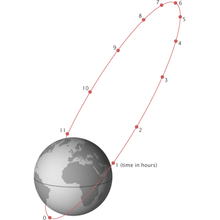
Back Òrbita Mólnia Catalan Molnija-Orbit German Órbita de Mólniya Spanish مدار مولنیا Persian Molnija-kiertorata Finnish Orbite de Molnia French מסלול מולניה HE Molnyija-pálya Hungarian Orbit Molniya ID Orbita Molnija Italian


A Molniya orbit (Russian: Молния, IPA: [ˈmolnʲɪjə] , "Lightning") is a type of satellite orbit designed to provide communications and remote sensing coverage over high latitudes. It is a highly elliptical orbit with an inclination of 63.4 degrees, an argument of perigee of 270 degrees, and an orbital period of approximately half a sidereal day.[1] The name comes from the Molniya satellites, a series of Soviet/Russian civilian and military communications satellites which have used this type of orbit since the mid-1960s. A variation on the Molniya orbit is the so-called Three Apogee (TAP) orbit, whose period is a third of a sidereal day.
The Molniya orbit has a long dwell time over the hemisphere of interest, while moving very quickly over the other. In practice, this places it over either Russia or Canada for the majority of its orbit, providing a high angle of view to communications and monitoring satellites covering these high-latitude areas. Geostationary orbits, which are necessarily inclined over the equator, can only view these regions from a low angle, hampering performance. In practice, a satellite in a Molniya orbit serves the same purpose for high latitudes as a geostationary satellite does for equatorial regions, except that multiple satellites are required for continuous coverage.[2]
Satellites placed in Molniya orbits have been used for television broadcasting, telecommunications, military communications, relaying, weather monitoring, early warning systems and some classified purposes.
- ^ Kolyuka, Yu. F.; Ivanov, N. M.; Afanasieva, T. I.; Gridchina, T. A. (28 September 2009). Examination of the Lifetime, Evolution and Re-Entry Features for the "Molniya" Type Orbits (PDF). 21st International Symposium of Space Flight Dynamics. Toulouse, France: Mission Control Center 4, Korolev, Moscow. p. 2. Retrieved 22 May 2018.
- ^ Ilčev, Stojče Dimov (2017). Global Satellite Meteorological Observation (GSMO) Theory. Vol. 1. Springer International Publishing. p. 57. ISBN 978-3-319-67119-2. Retrieved 16 April 2019.